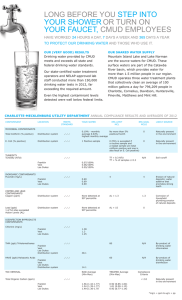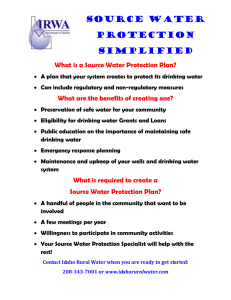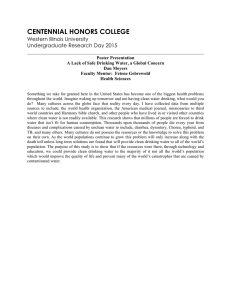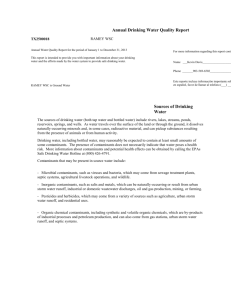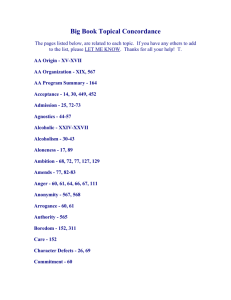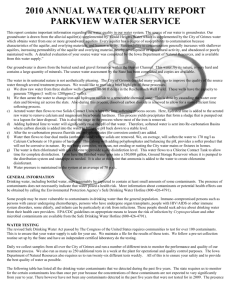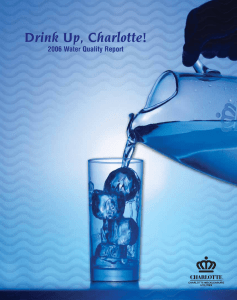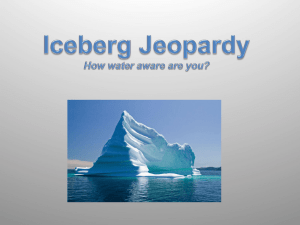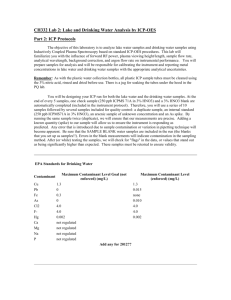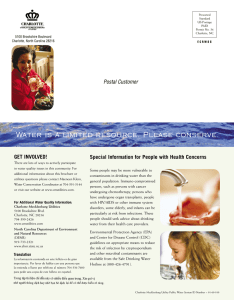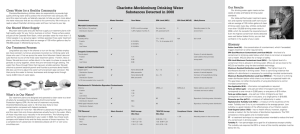CLEAN WATER For a Healthy Community
advertisement
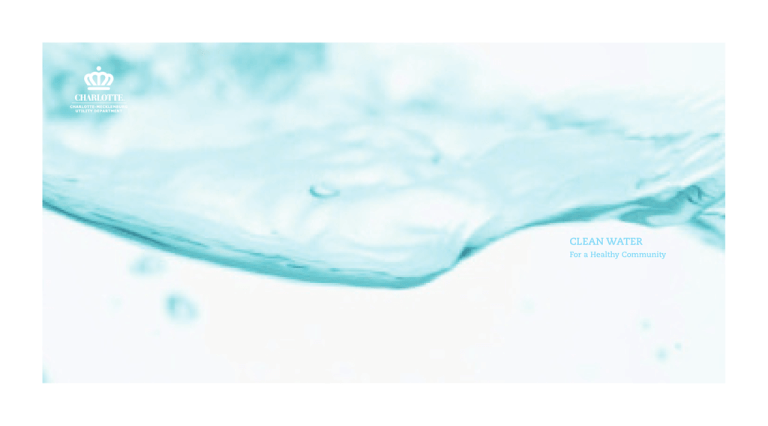
CLEAN WATER For a Healthy Community PROTECTING THE ENVIRONMENT AND PROVIDING CLEAN DRINKING WATER IS A RESPONSIBILITY THAT THE CHARLOTTE-MECKLENBURG UTILITY DEPARTMENT TAKES VERY SERIOUSLY. WE SEND THIS REPORT ANNUALLY, OUR (VERY GOOD) RESULTS AS REQUIRED BY THE EPA, TO HELP Drinking water provided by CMUD CUSTOMERS LEARN MORE ABOUT meets and exceeds all state and OUR CRITICAL WATER RESOURCES. federal drinking water standards. READ ON TO LEARN MORE ABOUT MECKLENBURG COUNTY’S DRINKING Our state-certified water treatment WATER SUPPLY AND HOW IT ARRIVES operators and lab staff conducted TO YOUR HOME OR BUSINESS. more than 150,000 drinking water tests in 2011. Even the highest contaminant levels detected were well below federal limits. WHAT EPA WANTS YOU TO KNOW Drinking water, including bottled water, may reasonably be expected to contain at least small amounts of some contaminants. The presence of contaminants does not necessarily indicate that water poses a health risk. Some people may be more vulnerable to contaminants in drinking water than the general population. Immunocompromised persons, such as persons with cancer undergoing chemotherapy, persons who have undergone organ transplants, people with HIV/AIDS people in Charlotte, Cornelius, or other immune system disorders, Davidson, Huntersville, Pineville, and some elderly and infants can be Matthews and Mint Hill. particularly at risk from infections. These people should seek advice OUR TREATMENT PROCESS about drinking water from their CMUD employees work 24 hours health care providers. a day, 7 days a week, and 365 days a year to provide safe, high quality If present, elevated levels of lead drinking water. Water from Mountain can cause serious health problems, Island Lake and Lake Norman feeds especially for pregnant women and three water treatment plants – young children. Lead in drinking Franklin, Vest or Dukes. water is primarily from materials and components associated with service We add aluminum sulfate (alum) lines and home plumbing. to the water to make dirt particles clump together for easy removal. OUR SHARED WATER SUPPLY The water then flows through Mountain Island Lake and Lake filters that trap smaller particles Norman are the source waters for and chlorine is added to prevent CMUD. These surface waters are bacterial growth. Fluoride is also part of the Catawba River basin, added at this stage to promote which provides water for more than dental health and lime is added to 1.5 million people in our region. CMUD adjust the water’s pH and prevent operates three water treatment plants pipe corrosion. Water is then pumped that collectively clean an average of through more than 4,000 miles of 110 million gallons a day for 788,000 water distribution mains. SOURCE WATER ASSESSMENT FOR MORE INFORMATION STATE OF NORTH CAROLINA SPANISH PROGRAM RESULTS OR QUESTIONS To obtain a printed copy of the La información contenida en este folleto SWAP report, please mail a written es de gran importancia. Converse con una request to: persona que la comprenda o llame por The state’s Source Water Assessment Program(SWAP) conducts periodic CHARLOTTE/MECKLENBURG evaluations of all drinking water For a complete list of substances sources across North Carolina to monitored but not detected, please Source Water Assessment determine their susceptibility to call 311 or visit www.cmutilities.com Program – Report Request potential contaminant sources. A teléfono al número 1 para pedir una copia de estefolleto en español. 1634 Mail Service Center VIETNAMESE Raleigh, NC 27699-1634 Tài liệu này có tin tức quan trọng về nước uống rating of “higher” does not indicate ENVIRONMENTAL poor water quality– only the system’s PROTECTION AGENCY vulnerability to become contaminated More information about contaminants You can also email your request in the future by potential sources. and potential health effects can be to swap@ncmail.net or visit obtained by calling the Environmental www.ncwater.org/pws/. If you The susceptibility rating for each Protection Agency’s Safe Drinking have any questions about the water source was determined by con- Water Hotline. SWAP report, please contact the sidering the number and location of 800.426.4791 Source Water Assessment staff potential contaminants, along with http://www.Epa.Gov/safewater/lead by phone at 919-715-2633. của quý vị. Hãy nhờ người dịch cho quý vị, hoặc hỏi người nào hiểu tài liệu này. the conditions of your water source and watershed. Source Inherent Vulnerability Rating Contaminant Rating Susceptibility Rating Date Mt. Island Lake/ Catawba River Moderate Moderate Moderate March 2010 Lake Norman Higher Higher Higher March 2010 Source Water Treatment Assessment Storage and Distribution Q AND A Why does CMUD add chlorine and fluoride to our drinking water? Chlorine is added to kill bacteria and prevent waterborne illness, and fluoride provides a defense against tooth decay. Both of these substances are added to water during the water treatment process. Fluoride has been proven to promote oral health and CMUD has added fluoride to our water since 1949. At such low levels, chlorine and fluoride do not pose a health risk but provide a significant health benefit. Is our water hard or soft? Hardness is primarily a measurement of calcium and magnesium concentration. Water is considered hard if it measures more than 125 parts per million, or 7.5 grains per gallon of trace minerals. Our water has a hardness measure of 30 parts per million, or 1.8 grains per gallon, which is considered soft. How does CMUD take care of our water and sewer system? Since its creation in 1972, CMUD has made strategic infrastructure investments that have served our growing community while protecting public health, supplying high-quality drinking water and ensuring fire protection. Building and maintaining this countywide system to the safest standards requires key capital investments that, in turn, drive the overall budget for the department. Funded solely from rates and fees paid by customers, CMUD invests 63 cents of every dollar into infrastructure maintenance and improvements. For more information: To report a water quality or billing issue, please call CharlotteMecklenburg Customer Service at 311 or 704.336.7600. Visit www.cmutilities.com for details on water treatment, conservation, customer service, rates and more. TERMS Action Level (AL) – the concentration of a contaminant, which if exceeded, triggers treatment or other requirements. EPA Goal/Maximum Contaminant Level Goal (MCLG) – the level of a contaminant in drinking water below which there is no known or expected risk to health. MCLGs allow for a margin of safety. EPA Limit/Maximum Contaminant Level (MCL) – the highest level of a contaminant that is allowed in drinking water. MCLs are set as close to the MCLGs as feasible using the best available technology. Maximum Residual Disinfection Level (MRDL) – the highest level of a disinfectant allowed in drinking water. There is convincing evidence that addition of a disinfectant is necessary for controlling microbial contaminants. Maximum Residual Disinfection Level Goal (MRDLG) – the level of a drinking water disinfectant below which there is no known or expected health risk. This goal does not reflect the benefits of using disinfectants to control microbial contaminants. Million Fibers per Liter (MFL) – a measure of the presence of asbestos fibers that are longer than 10 micrometers. Non-Applicable (N/A) – information not applicable or required. Parts per billion (ppb) – one part per billion (micrograms per liter) corresponds to one minute in 2,000 years, or one penny in $10 million. Parts per million (ppm) – one part per million (milligrams per liter) corresponds to one minute in two years, or a single penny in $10,000. Nephelometric Turbidity Unit (NTU) – a measure of the cloudiness of the water. Turbidity over 5 NTU is just noticeable to the average person. Low turbidity is a good indicator of the effectiveness of our filtration system. Total Organic Carbon (TOC) – has no health effects; however, organics provide a medium for the formation of disinfection by-products. The TOC compliance criteria applies only to treated water. TT – a treatment technique is a required process intended to reduce the level of a contaminant in drinking water. Turbidity % – low percentages are a goal for all substances except turbidity. The turbidity rule requires that 95% or more of the monthly samples be less than or equal to 0.3 NTU. EPA limits are set at very stringent levels. To understand the possible health effects described for many regulated contaminants, a person would have to drink two liters of water every day at the MCL level for a lifetime to have a one-in-amillion chance of having the described health effect. CHARLOTTE-MECKLENBURG UTILITY DEPARTMENT ANNUAL COMPLIANCE RESULTS AND AVERAGES OF 2011 CONTAMINANT LOCATION MEETS STANDARD YOUR WATER *mg/L = ppm & ug/L = ppb EPA LIMIT MCL EPA GOAL MCLG LIKELY SOURCE MICROBIAL CONTAMINANTS Total coliform (% positive) Water Distribution System P 0.05% - Monthly Average Results of no more than 5% 0 Naturally Present 0.3% - Highest monthly average positive/month In The Environment TURBIDITY TT = 0.3 ntu N/A Soil Runoff TT = % of samples< _ 0.3 Turbidity (ntu)FranklinP0.06/100% VestP0.06/100% Lee DukesP0.05/100% INORGANIC CONTAMINANTS Fluoride (mg/L)FranklinP0.79 44Erosion Of Natural VestP0.88Deposits; Water Additive Lee Dukes P0.80That Promotes Strong Teeth COPPER AND LEAD CONTAMINANTS Copper (ppm) Water Distribution System P None Detected AL = 1.3 1.3 Corrosion Of Household @ 90th Percentile Plumbing; Erosion Of Natural Deposits Lead (ppb) Water Distribution System P None Detected AL = 15 0 Corrosion Of Household 1 Of 54 Sites Exceeded Action Levels (AL)@90th PercentilePlumbing; Erosion Of Natural Deposits Chlorine (mg/LFranklinP1.35 VestP1.36 Lees DukesP1.20 *DISINFECTION BYPRODUCTS CONTAMINANTS THM(ppb) Trihalomethanes Water Distribution System P 45.8 80N/ABy-product Of Drinking Water Disinfection HAA5(ppb) Haloacetic Acids Water Distribution System P12.2 60 By-product Of Drinking Water Disinfection TOC REMOVAL LOCATION MEETS STANDARD RAW AVERAGE(MIN-MAX) TREATED AVERAGE(MIN-MAX) COMPLIANCE CRITERIA LIKELY SOURCE Total Organic Carbon (ppm) < 2.0Naturally Present Franklin P 1.39 (0.69-1.70) 0.90 (0.64-1.22) In The Environment Vest P 1.47 (1.21 - 1.59) 0.89 (0.69-1.06) Lee Dukes P 1.38 (1.25 - 1.55) 0.87 (0.62-1.04) * Non-detected substances not listed. For full list, call 311 or visit www. cmutilites.com
